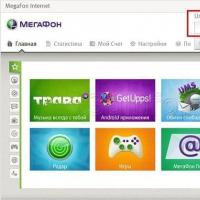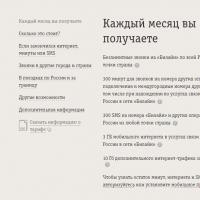Disk check d. CHKDSK How to check and fix hard disk errors. Options for the NTFS file system
For health hard disk Like any other component of a computer or laptop, you need to make sure that it does not fail ahead of time. In this article, we will get acquainted with the built-in OS Windows utility hard disk check chkdsk... With its help, we will diagnose the HDD and correct the existing errors.
A hard disk is an integral part of a computer and carelessness towards it can disable it, in which case everything that was on it will disappear. work time and is unlikely to help here on its own. And in order not to lead to such a case, you need to check at least occasionally HDD for errors. Today I will not talk about powerful utilities such as Victoria or MHDD, about them another time. In today's article, we will look at the built-in utility in the operating room Windows system- chkdsk, it is designed to check the hard disk and fix problems on it.
And so, you need to open the command line. You can through Start - in the search for cmd, or use "Win + R", the "Run" dialog box will open, enter - cmd in the line and click OK. Windows Command Prompt will open.
Enter the command there: chkdsk c: / f / r
Where chkdsk is the hard drive check command
c: - the letter of the hard drive, if there are several disks or partitions on the computer and you need to check another, just enter the desired letter for example d: or e:
/ f - sets error correction on HDD.
/ r - fixes errors on the disk and restores part of the data that can still be read.
There are other commands, in order to familiarize yourself with them, you must enter the command: chkdsk /? Where will be displayed full list chkdsk commands.
After entering the command, the utility should start scanning. As soon as the scan is over, it will display its results. If you want to scan the system disk or partition (C), then in command line a message like this will come out:

The program will not be able to scan the system disk while it is running, so you need to restart your computer. And in order for the scan to begin immediately before loading the OS, you must enter at the bottom of this message in the command line Y and press Enter. The computer will restart and start scanning the disk.
The built-in utility in Windows for checking the HDD can be launched without the command line, it has a graphical mode. In order to start the scan in graphical mode, you need to enter My Computer, select desired disk, for example C: / click on it with the right mouse button, select "Properties" in the drop-down list of the context menu. Next, on the "Service" tab, under the "Check disk" item, click on "Run check".

In the window that opens, click "Start".

If you check the system drive (C), the computer will ask you to reboot (Schedule disk check) and only then start the check before loading the OS, if you need to check any other disk or partition, then the scan will start immediately.

How can I disable chkdsk scanning at startup?
Sometimes users face this problem when chkdsk utility automatically starts scanning the HDD when the computer boots up. This happens because errors are found on the hard disk and the system automatically tries to fix it. It is not recommended to disable automatic scanning of chkdsk, it can damage the hard disk. If you nevertheless decide to disable, then you can do it like this: enter in the command line - chkntfs / x c: d: and press Enter.
Where "c" and "d" are drive (partition) letters. And after that, chkdsk auto scan at startup will be disabled.
This concludes an overview of the built-in Windows programs CHKDSK for checking and fixing errors on the hard disk is coming to an end, if you have any questions on this topic, please contact.
 Quite often, a computer or laptop is associated precisely with errors and malfunctions in the hard drive. In this article, we will figure out how to check the health of a hard drive using Windows tools and specially designed programs for this.
Quite often, a computer or laptop is associated precisely with errors and malfunctions in the hard drive. In this article, we will figure out how to check the health of a hard drive using Windows tools and specially designed programs for this.
Checking for errors by standard means
This method is equally effective for Windows Xp, Vista, 7, 8 and 10. You need:

If the notification "Windows cannot check the drive that is currently in use" appears, you should click "Check Schedule".
So, now we do a reboot, and when the system boots, a performance test will run through the BIOS and fix media errors. Its duration can be from 2-3 minutes to an hour, depending on the characteristics of the hard drive and its capacity.
Checking the hard disk for errors via the command line
To start the check, you need to run next steps: go to "Start / All programs / Accessories / Command line". Clicking right key mouse and click "Run as Administrator".

In the window that appears, execute the command "chkdsk disk_partition: check_parameters". It should be borne in mind that this way works exclusively with drives that have been formatted in FAT32 or NTFS.
An example of a command is "chkdsk C: / F / R". Its essence is as follows:
- Section C will be checked for errors;
- Found problems will be automatically corrected (parameter F is responsible for this);
- Bad sectors will be checked and information restored (parameter R);

If you want to diagnose the drive used by the system in this moment, you will see special notice... You will be prompted to perform a check the next time you boot your computer. To agree with this, press Y, to refuse - N. Based on the results of the check, information about the verified data, about the quantity bad sectors and errors found.
For a complete list of options, run chkdsk with a question mark as a parameter. But if you need a routine check for errors and sectors, then the above information will be enough for you.

It happens that the errors found during scanning are not always possible to immediately fix, it is likely that this is due to the program running at that time. In this situation, an offline scan of the drive will be required: it is disconnected from work, diagnostics are carried out, and then it is connected back. To do this, enter into the command line "chkdsk C: / f / offlinescanandfix" (C: - disk partition). If it is not possible to disable it, then the check will be performed at the next reboot.

If necessary, after checking, you have the opportunity to study the check log. For this you need:
- Go to Windows logs/ Applications;
- Right-click on Application / Search;
- Search for the word Chkdsk;

Program check
Of course, the above method is not always effective. Therefore, we will look at a number of programs like Victoria. They will allow you to conduct the most thorough analysis of the state of the hard drive on a computer or laptop.
Victoria

Utility for diagnostics and testing of the hard drive. It will help you not only find problems in its work, but also fix them.
The program has a number of advantages and useful functions:
- Reads the hard drive's passport and provides detailed information;
- 5 diagnostic modes;
- Eliminates crashes;
- Displays unstable areas;
- Hides defects;
- Evaluates the performance of the media.
It is one of the best to date. It is able to solve problems with bad sectors and quickly bring any type of hard drive to a working state.
HDD Regenerator

One of the most effective programs to assess the status and troubleshoot drives. It makes it possible to obtain information on the current SMART state of the selected device and full control over it.
Among the main features are:
- Simple and intuitive interface;
- Full safety;
- NTFS and FAT support;
- Pre-scan mode;
HDD monitoring in real time;
That is, with the help of the regenerator, you can test the hard drive as efficiently as possible.
TestDisk

Designed to determine the status and test drives. In addition to simple diagnostics, it also detects broken sectors and fixes all found errors. Its main functions include:
- Analyze the current state of the hard drive;
- Search for broken sectors;
- Recovering deleted partitions;
- Fix MFT;
Checking external hard drives;
In addition, the utility has a number of other functions related to recovering deleted files.
Hitachi Drive Fitness Test

An excellent program designed to find and fix problems with drives. It is universal, as it can diagnose any drives. With its help, you can extremely quickly find out the current position of the hard drive, as well as get about it Additional information.
Includes:
- Fast but thorough check;
- Support for all components;
- Monitoring;
- Data statistics;
This utility is suitable for all devices and can be used even on a netbook.
Seagate Seatools for Windows

Used to check and test the health of the hard disk. She finds any problems and failures.
- The utility is able to fix:
- Equipment incompatibility;
- Violations file system HDD;
- Errors of installed drivers;
- Viruses and malware that infect the file system;
In addition, it provides complete information about the media and all related metrics. As the developers say, this utility incredibly effective in self-correction minor problems SSD errors and HDD, and is able to fully restore their performance.
So now you have complete information how to determine if a hard drive is working properly, and how to independently solve problems associated with it. Choose the most suitable or the option you like and go for it!
Video: checking hard with regular means
Diagnostics and elimination of errors on the hard disk
3 (60%) 2 vote (s)You can check your hard drive for errors and fix them both with the help of third-party programs and through the built-in services that are in Windows by default. Next, we will consider several ways to perform automatic check hard drive and troubleshoot problems found on it.
Check disk for errors in Windows 7
Diagnostics can be performed through the Command Prompt, Disk Properties, PowerShell, and Control Panel. Each of the suggested options scans the disk for errors different types, therefore, it is recommended to use all three instructions and only after that, if the problem is not found, resort to diagnostics via third party programs.
Checking the hard drive using commands
Through disk properties

Video Tutorial: Checking HDD
Through PowerShell

Using the control panel

Using third-party programs to diagnose and check the hard drive for bad sectors
If check disk standard methods did not bring the desired results, then you can use third-party programs that perform disk diagnostics.
You can download the program for free from this site - http://programdownloadfree.com/load/system/test_hdd/victoria/71-1-0-122. Its capabilities and advantages are in the following parameters:

HDAT 2
Similar previous application but supportive large quantity models of the hard disk and its modes of operation. The official website of the program is https://hdat2.com.
CrystalDiskInfo
The program has a beautiful and understandable design, as well as the presence of the Russian language. Official site of the developer -
http://crystalmark.info/?lang=en. In addition to the basic functions common to all the above programs, CrystalDiskInfo supports diagnostics external storage, checks the status and temperature of the HDD, has a wide selection of disk settings.
Fixes found issues
In most cases, the errors found will be fixed automatically. But sometimes, the computer can detect an error, but not get rid of it, but only inform you about its presence. In this case, you must correct the error yourself.
Using the Victoria program
The Victoria application can both scan the disk for errors and fix the found ones.

So, checking a hard drive or SSD can be done both with the help of third-party and through built-in programs. In most cases, the errors found will be fixed automatically. Before starting to work with the disc, it is recommended to restart the computer, the same should be done after you have finished working with it.
This step-by-step instruction will help you check hard drive for errors in Windows 7, 8.1, 10. We will do it via command line or through the explorer menu .
Note that the use of any third parties is not provided. Everything is checked by the resources of the computer itself and operating system... Why, you ask? I explain: this is done for the reason that most the most powerful programs, which are designed specifically for verification, are little familiar and incomprehensible to the user. Therefore, when using programs little known to you, you can do more harm to your computer.
Checking the hard drive using the command line
For a start, it is necessary. In newer versions of Windows 8.1 and 10, this can be done by right-clicking on the " Start", Then select the item" Command line (administrator)».
In it (on the command line), enter the command chkdsk drive_letter: check_options .
*Check Disk only works with disks that have been formatted with NTFS or FAT32.

Well, for example: chkdsk C: / F / R - the command indicates the check of the C drive, and errors will be corrected automatically - the F parameter, and the check for bad sectors and an attempt to restore them - the R parameter.
In the event that you want to check the disk that the system is currently using, you will see a message stating that the check can start after restarting the computer. Accordingly, you can refuse or agree ( Y - agree, N - refuse).
In other cases, after checking, you will receive statistics of the checked data, errors found and sectors that were corrupted.

If you want to know the parameters of the program in more detail, you can run chkdsk, and specify a question mark as a parameter.
So, after the end of the check, you can see its results in the log Check Disk... To do this, you need to press Win + R and introduce eventvwr.msc... In the Windows Logs - Application section, search for keyword Chkdsk.

Checking the hard drive through Windows Explorer
This is the easiest way to check your hard drive.
To do this, go to " My computer", And right-click on the disk that we want to check. We choose " Properties"→ Tab" Service» → « Verify».
Usually, in Windows 8.1 and Windows 10, a message appears stating that a disk check is not required at the moment. But you can force it.

By the way, in Windows 7 it is possible to select the appropriate items for verification, which allow you to enable verification and fix errors automatically.
I wrote an article about checking hard drives for errors, it also mentioned that it is impossible to check the disk that is used by the system. Examination system disk runs as scheduled on next reboot.
However, sometimes the system disk check does not start after a reboot. If you encounter such a problem, do the following:
1) The autochk.exe file is responsible for the check that should have happened after the reboot, which is located in the following path: C: \ Windows \ System32 (C: \ is the drive on which Windows is installed, you may have a different drive letter). You need to check if this file exists in the given directory.
2) Press “Win + R” write “regedit” and press Ok, the registry editor will start, go to the following path:
HKEY_LOCAL_MACHINE \ SYSTEM \ CurrentControlSet \ Control \ Session Manager
In the right column, find the BootExecute parameter, double-click on it with the left mouse button. The value should be “autocheck autochk *”, if there is another value, change it to autocheck autochk *.
Incorrectly editing the registry can harm the OS. Before you start working with the registry, I advise you to read.
After you schedule a system disk check, the value of the BootExecute parameter will change, the entry will look like this:
autocheck autochk / p \ ?? \ C:
After checking the disk (after rebooting), the entry “autocheck autochk / p \ ?? \ C:” will disappear and only autocheck autochk * will remain.
Sound does not work
If after you have restarted your computer and the system disk has been checked, you have lost sound, then you need to restart windows service Audio. To do this, go to the following path:
Control Panel \ All Control Panel Items \ Administrative Tools \ Services.
Find a service called Windows Audio, right-click on it and select “Restart”.

 SMS with the word "Good" will save hundreds of sick children
SMS with the word "Good" will save hundreds of sick children "All inclusive L" from Beeline Description and general characteristics of tariffs
"All inclusive L" from Beeline Description and general characteristics of tariffs How to create a personal account on Beeline?
How to create a personal account on Beeline? Flash and unlock modem ZTE MF823D Unlock modem s Huawei
Flash and unlock modem ZTE MF823D Unlock modem s Huawei Installed package abroad
Installed package abroad Portable speaker JBL GO Black
Portable speaker JBL GO Black Terms of use of tariff in roaming
Terms of use of tariff in roaming